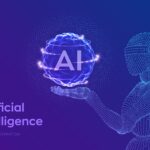
Data science is a critical part of many sectors, and it is one of the most fiercely debated topics in IT circles, given the massive amounts of data collected nowadays. Its popularity has grown over time, and companies have begun to employ data science techniques to expand their operations and boost customer satisfaction. Let’s discover more about what data science is and its Prerequisites, Lifecycle, and Applications.
What is Data Science?
Data science and machine learning is the study of large amounts of data and the extraction of useful insights from raw, structured, and unstructured data using the scientific method, various technologies, and algorithms.
It is a multidisciplinary field that employs tools and techniques to modify data to discover new and relevant information.
To solve data-related problems, data scientists employ the most powerful technology, programming platforms, and efficient algorithms. It is the artificial intelligence of the future.
In a nutshell, data science is concerned with:
- Identifying the right questions to ask and assess the raw data.
- Using a variety of complex and efficient algorithms to model the data.
- To gain a better understanding of the data, visualize it.
- To make better decisions and determine the result, you must first understand the data.
Need for Data Science:
Every firm now faces a difficult problem in dealing with such vast amounts of data. So we needed some complex, powerful, and efficient algorithms and technologies to handle, process, and analyze this, and that technology became known as data Science. The following are some of the most important reasons to use data science technology:
- We can turn enormous amounts of raw and unstructured data into relevant insights using data science technology.
- Various businesses, whether large or small, are using data science technology. Google, Amazon, Netflix, and other companies that deal with large amounts of data use data science algorithms to improve customer experience.
- Data science is striving to automate transportation, such as developing a self-driving automobile, which is the transportation of the future.
- Data science can help with elections, surveys, aircraft ticket confirmation, and other predictions.
The Data Science Lifecycle
Let’s take a look at the data science lifecycle now that you know what it is. There are five stages to the data science lifecycle, each with its own set of responsibilities:
- Capture: The data gathering process includes processes such as data entry, data collection, signal receiving, and data extraction. This stage comprises collecting raw unstructured and structured data.
- Maintain: Data warehousing includes data staging, data cleansing, data processing, and data architecture. This stage comprises turning raw data into a format that can be used.
- Process: Data mining techniques include clustering/classification, data mining, data modeling, and data summarization. Data scientists look for ranges, patterns, and biases in the data to see if they can be used in predictive analysis.
- Analyze: Exploratory/confirmatory, Regression, Text Mining, Qualitative Analysis, Predictive Analysis This is where the lifecycle becomes serious. This stage entails conducting various analyses of the data.
- Communicate: Decision Making, Data Reporting, Data Visualization, Business Intelligence Analysts present the studies in clearly legible forms such as charts, graphs, and reports in the last step.
Prerequisites for Data Science
Non-Technical Prerequisite:
- Curiosity: Curiosity is essential for learning data science. You can quickly comprehend the company challenge if you are curious and ask various inquiries.
- Critical Thinking: It’s also necessary for a data scientist to be able to come up with several fresh solutions to address a problem quickly.
- Communication skills: A data scientist’s communication skills are crucial since, after solving a business problem, you must share your findings with the rest of the team.
Technical Prerequisite:
- Machine learning: To grasp the concept of data science, one must first grasp the concept of machine learning. Machine learning algorithms are used in data science to solve various challenges.
- Mathematical modeling: To create quick mathematical computations and predictions using accessible data, mathematical modeling is required.
- Statistics: A basic understanding of statistics, such as mean, median, and standard deviation, is essential. It’s necessary to extract knowledge and improve results from data.
- Computer programming: Knowledge of at least one programming language is essential for data science. R, Python, and Spark are examples of data science programming languages.
- Databases: Data science requires a thorough understanding of databases, such as SQL, to obtain data and work with it.
Tools for Data Science
The following are some essential data science tools:
- Data Analysis tools: R, MATLAB, Statistics, Python, Jupyter, SAS, R Studio, Excel, RapidMiner.
- Data Warehousing: ETL, SQL, Hadoop, Informatica/Talend, AWS Redshift
- Data Visualization tools: R, Jupyter, Tableau, Cognos.
- Machine learning tools: Mahout, Spark, Azure ML studio.
Data Science Components:
The following are the main components of Data Science:
- Statistics
Statistics is one of the most important areas of data science. Statistics is a technique for collecting and evaluating large volumes of numerical data in order to draw useful conclusions.
- Domain Expertise
Domain expertise is what holds data science together. Domain expertise refers to specialized knowledge or abilities in a specific field. Domain specialists are required in a number of areas of data science.
- Data engineering
Data engineering is a branch of data science that deals with data acquisition, storage, retrieval, and transformation. Data engineering also involves metadata (information about information).
- Visualization
Data visualization is defined as the representation of data in a visual environment so that people may quickly grasp its meaning. The massive amount of data in images may be easily accessed with data visualization.
- Advanced computing
Advanced computing is the backbone of data research. The source code of computer programs is designed, written, debugged, and maintained in advanced computing.
- Mathematics
Data science relies heavily on mathematics. Quantity, structure, space, and change are all studied in mathematics. A data scientist must have a solid understanding of mathematics.
- Machine learning
The backbone of data science is machine learning. Machine learning is the process of teaching a machine to function like a human brain. To answer challenges in data science, we use a variety of machine learning algorithms.
What Does a Data Scientist Do?
You’ve heard of data science and are probably curious about what this Data scientist job entails, here’s your answer. A data scientist examines corporate data to derive useful information. To put it another way, a data scientist solves business problems by following a set of procedures, which include:
- The data scientist determines the problem by asking the correct questions and acquiring understanding before beginning data collecting and analysis.
- After that, the data scientist selects the appropriate variables and data sets.
- The data scientist collects organized and unstructured data from a variety of sources, including enterprise and public data.
- After the data is acquired, the data scientist analyses it and converts it into an analysis-ready format. Cleaning and verifying data are required to ensure uniformity, completeness, and accuracy.
- The data is put into the analytic system—an ML algorithm or statistical model—after it has been converted into a usable form. This is where data scientists look for patterns and trends to examine.
- The data scientist evaluates the data once it has been rendered completely to uncover possibilities and solutions.
- The mission is completed when the data scientists produce and communicate the results and insights to the right stakeholders.
Now we should be aware of a few machine learning algorithms that will help us better grasp data science.
Where Do You Fit in Data Science?
You can concentrate on and specialize in a certain aspect of data science. Here are some examples of how you might get engaged in this fascinating and rapidly expanding field.
Data Scientist
- Job role: Determine the problem, the questions that need to be answered, and the data sources. They also collect, clean, and present pertinent data.
- Skills needed: Programming skills (SAS, R, Python), Hadoop, data visualization and storytelling, SQL, statistical and quantitative skills, and Machine Learning understanding.
Data Analyst
- Job role: Analysts connect data scientists and business analysts by arranging and analyzing data to respond to the organization’s questions. They translate the technical analyses into actionable items.
- Skills needed: Statistical and mathematical skills, programming skills (SAS, R, Python), and data wrangling and data visualization experience are all required.
Data Engineer
- Job role: Data engineers work on the organization’s data infrastructure and data pipelines, building, deploying, managing, and improving them. Data scientists benefit from engineers’ help with data transit and transformation.
- Skills needed: NoSQL databases (e.g., MongoDB, Cassandra DB), Java and Scala programming languages, and frameworks (Apache Hadoop).
Applications of Data Science
Data science is currently applied in virtually every industry.
- Healthcare
Healthcare companies are employing data science to create improved medical technologies that can diagnose and treat illnesses.
- Gaming
Data science is currently being used to build video and computer games, which has elevated the gaming experience to new heights.
- Image Recognition
One of the most prominent data science applications is detecting objects in photos and identifying patterns in them.
- Recommendation Systems
Netflix and Amazon make movie and product suggestions based on your viewing, purchasing, and browsing habits on their platforms.
Logistics
Logistics organizations employ data science to optimize routes to assure faster product delivery and increase operational efficiency.
Fraud Detection
To detect fraudulent transactions, banks and financial institutions use data science and related algorithms.
Wrapping It All Up
Data will be the commercial world’s lifeblood for the foreseeable future. Data is actionable knowledge that may determine whether a company succeeds or fails, and knowledge is power. By incorporating data science techniques into their operations, businesses can now forecast the future growth, anticipate potential difficulties, and develop informed success plans.







